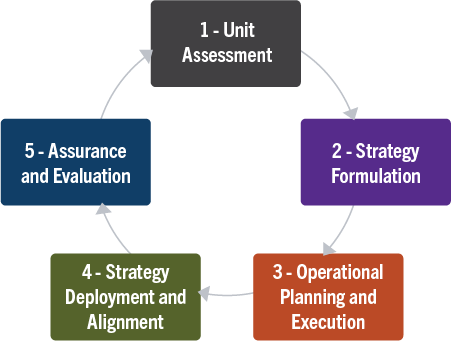Strategic and Operational Planning
The Five Strategy Lifecycle Phases
1. Unit Assessment
Deep strategic thinking and unit assessment to establish a foothold for change
Unit assessment involves conducting a thorough analysis of the internal and external environments in which the unit operates. This includes environmental scanning to identify trends in higher education and stakeholder needs, competitive landscape, and internal capabilities.
-
Common Tools and Outcome
Common Tools
- Scenario Planning
- SWOT (strengths, weaknesses, opportunities, threats)
- Environmental Scan
Outcome
The results of this phase include a broad understanding of internal and external forces and stakeholders that can impact, positively or negatively, the success of leaders' strategic decisions and actions. This knowledge provides a foundation for informed decision-making in the subsequent phases. Strategic scenario planning and benchmarking can provide an understanding of the current position and potential future challenges and opportunities.

2. Strategy Formulation
Develop a high-level strategy, including identifying what success looks like and what it will take to get there.
In this phase, we define mission, vision and strategic goals and establish the principles that guide our work and actions.
-
Common Tools and Outcome
Common Tools
- Mission
- Vision
- Principles
- Goals
Outcome
This phase is crucial for setting a clear direction, outlining what the unit aims to achieve and the ethical framework within which it operates. The outcome is a strategic plan that aligns with long-term aspirations and stakeholder expectations.
3. Operational Planning and Execution
Translate high-level strategy into operational planning and action items to address gaps.
In this phase, the unit translates strategic goals into actionable operational plans. It involves developing detailed implementation plans, identifying necessary resources, setting timelines, and establishing measures and metrics to track progress.
-
Common Tools and Outcome
Common Tools
- Objectives
- Milestones and Actions
- Roadmaps
- Measures and Metrics
- Gap Analysis
Outcome
Strategic projects are defined, and responsibilities are assigned to ensure the unit can effectively execute its strategy. This phase ensures that the strategic vision is broken down into manageable and measurable components.
4. Strategy Deployment and Alignment
Make the strategic plan achievable by involving the organization in owning their part of the strategic plan. Individuals align their performance goals to unit objectives and milestones.
This phase of the strategy lifecycle focuses on communicating the strategy across the institution and ensuring that all levels are working toward the same goals. It involves vertical and horizontal integration to align unit strategic and operational plans with the University's overall strategy (Clemson Elevate).
-
Common Tools and Outcome
Common Tools
- Communication Plan
- Up/down/across communication feedback
- Strategy to Action Plan
- Catchball
Outcome
Effective communication ensures that employees understand their role in the strategic plan's execution, with performance plans aligned to strategic objectives. This alignment is critical for cohesive and coordinated efforts throughout the University.
5. Assurance and Evaluation
Ongoing refinement and evaluation of performance, culture, communications, data reporting and other strategic management issues.
This phase involves continuous monitoring and reporting on the progress of the strategic plan's implementation. Dashboards and metrics tracking provide insights into performance against strategic goals.
-
Common Tools and Outcome
Common Tools
- Strategic Reviews
- Reports
- Dashboards and Scorecards
- Communication
Outcome
Regular reviews identify areas needing adjustment, ensuring the strategy remains relevant and effective in changing conditions. This phase ensures accountability and facilitates ongoing improvements, allowing the unit to adapt and refine its strategic plan as necessary.
